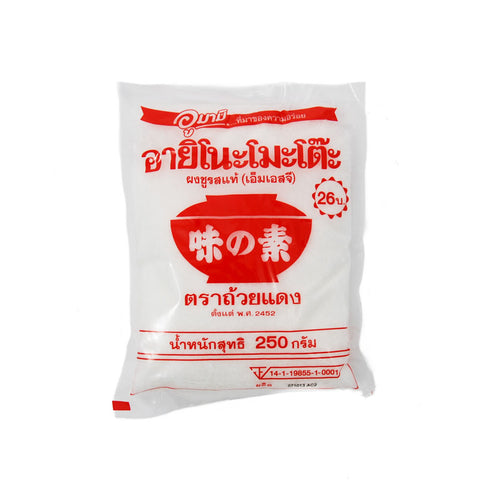What is in MSG Seasoning?

Monosodium glutamate, known as MSG, is a flavour enhancer that has been widely used in cooking for many decades. With its ability to bring out the umami taste, MSG seasoning is a staple in many kitchens across the world.
But what exactly is in MSG seasoning? In this piece, we look into the composition of MSG, and its role in the kitchen.
Plus, we look at some common misconceptions around MSG and the debate it can provoke.
Origins and History of MSG
MSG seasoning’s story begins in Japan in 1908 when Professor Kikunae Ikeda extracted glutamate from seaweed broth. He discovered that glutamate (naturally occurring in ingredients like tomatoes and mushrooms) was responsible for the savoury taste in food.
By combining glutamate with sodium, Ikeda created monosodium glutamate, a stable and easy-to-use seasoning. MSG quickly gained popularity in Japan and spread across Asia for its ability to enhance flavours.
By the mid-20th century, MSG had made its way to the Western world, where it became a common addition in processed foods and restaurant dishes.
Common Misconceptions
MSG seasoning has faced its fair share of controversy over the years. With many people calling out the potentially racist and unscientific claims surrounding MSG.
One of the most prevalent myths is that MSG causes adverse health effects. And perhaps most shockingly, it was once linked to a health condition termed “Chinese Restaurant Syndrome” in the Merriam-Webster's Dictionary.
In 1993, the dictionary published an entry for Chinese Restaurant Syndrome: "A group of symptoms (such as numbness of the neck, arms, and back with headache, dizziness, and palpitations) that is held to affect susceptible persons eating food and especially Chinese food heavily seasoned with monosodium glutamate."
This notion originated from anecdotal reports in the 1960s but has since been entirely debunked by numerous scientific studies.
A common misconception is that MSG is unnatural or synthetic. Understanding that MSG is simply a concentrated form of a natural amino acid can help dispel these myths.
In fact, a 2019 paper in the journal 'Food Science and Food Safety' concluded that claims linking MSG to an assortment of ailments were unsubstantiated.
Regulatory authorities European Food Standards Agency have also deemed MSG entirely safe for consumption at normal levels.
Global Usage of MSG
In Asian food, MSG powder is a staple in many kitchens, used to enhance the flavours of soups, stir-fries, and sauces. Japanese, Chinese, and Korean cuisines, in particular, use MSG to create the umami taste that defines many of their dishes.
Meanwhile in Latin American and African cuisines, MSG is gaining popularity. This widespread use underscores MSG’s universal appeal and effectiveness in bringing out the best in food, making it an indispensable ingredient in global gastronomy.
Key Ingredients in Monosodium Glutamate (MSG)
Primary Component: Glutamate
The primary component of MSG seasoning is glutamate, an amino acid that occurs naturally in many foods. Glutamate is one of the building blocks of protein and is prevalent in foods like tomatoes, cheese, and mushrooms.
What makes glutamate special is its ability to activate specific taste receptors on the tongue, thereby creating the savoury, umami flavour. This unique taste is often described as the fifth basic taste, distinct from sweet, salty, sour, and bitter.
In MSG, glutamate, derived from glutamic acid, is combined with sodium to form monosodium glutamate, making it more stable and easier to incorporate into dishes. By understanding the role of glutamate, we can better appreciate how MSG works to enhance the natural flavours of food, making meals more enjoyable and satisfying.
Other Food Additives
MSG seasoning is often associated solely with monosodium glutamate, but it can include other additives to enhance its effectiveness and shelf life. MSG contains only one third the sodium of table salt (sodium chloride).
Common additional ingredients may include anti-caking agents like silicon dioxide, which prevents clumping and ensures even distribution when sprinkled onto food. Sometimes, flavour enhancers such as disodium inosinate and disodium guanylate are added.
These compounds work synergistically with glutamate to intensify the umami taste. It’s worth noting that these additives are generally regarded as safe by food regulatory agencies. However, for those with specific dietary restrictions or allergies, it’s essential to read labels carefully. By understanding what is in MSG seasoning, consumers can make informed choices that best suit their culinary and dietary needs.
Natural Sources - How is MSG Made?
While MSG seasoning is a manufactured product, its primary component, glutamate, is naturally abundant in many foods.
MSG is often produced through the fermentation of sugar beets and other plant-based ingredients.
Tomatoes, for example, are rich in natural glutamate, which contributes to their deep, savoury flavour. Cheeses, especially Parmesan, are another excellent source, providing a concentrated umami taste that enhances many dishes.
Mushrooms, particularly shiitake, also contain high levels of glutamate, making them a popular ingredient in various cuisines for their meaty flavour. Even meat and fish are rich in natural glutamate, which is why they are so satisfying and flavourful.
By recognising these natural sources, we can see that the umami taste provided by MSG seasoning is not an artificial invention but a concentrated form of something already present in many of our favourite foods.
This understanding helps demystify MSG and highlights its role in enhancing the natural flavours we already enjoy.
Nutritional Details of MSG
MSG seasoning itself is low in calories, fat, and carbohydrates, making it a minimal addition to the overall nutritional profile of a dish.
It contains sodium, but less than table salt per gram, offering a way to reduce overall sodium intake while still enhancing flavour.
MSG is the sodium salt of glutamic acid, which is produced through the fermentation of plant-based ingredients.
MSG is also a source of glutamate, an amino acid that plays a role in various metabolic functions.
While MSG may not be packed with nutrients on its own, it can be a valuable component in a balanced, nutritious diet.
Does MSG Make You Feel Full?
MSG seasoning may also play a role in enhancing satiety, the notion of fullness after eating. Some studies suggest that the umami taste provided by MSG can increase the satisfaction derived from a meal by lighting up taste buds and communicating with calcium channels, potentially reducing the overall amount of food consumed.
Additionally, meals that are rich in umami flavours often include nutrient-dense ingredients like vegetables, lean proteins, and whole grains, further contributing to a feeling of fullness. Although of course, this is entirely circumstantial.
Addressing Health Concerns - Is MSG Dangerous?
Scientific Studies
Several scientific studies have been pivotal in dispelling the myths surrounding MSG seasoning.
Extensive research conducted by organisations such as the FDA, EFSA, and the World Health Organisation has consistently found that MSG is safe for consumption in normal dietary amounts.
Double-blind, placebo-controlled studies have debunked the so-called “Chinese Restaurant Syndrome,” showing no consistent link between MSG consumption and adverse health effects.
Moreover, research has highlighted that glutamic acid, the primary component of MSG, is a naturally occurring amino acid found in many everyday foods.
These studies affirm that when consumed in moderation, MSG does not pose any more risk than other common food additives.
By relying on scientifically backed evidence, consumers can feel more confident about including MSG seasoning in their diets, understanding that it is both safe and beneficial in enhancing the flavour of their meals.
Practical Uses in Cooking
Everyday Recipes
MSG seasoning can be a game-changer in your everyday recipes, enhancing the flavours of a variety of dishes with minimal effort.
MSG can be used to enhance the flavours of dishes that include soy sauce. For instance, adding a pinch of MSG to soups and stews can bring out the rich, savoury notes, making them more satisfying. It works wonders in marinades for meats, helping to tenderise and infuse flavour.
Stir-fries benefit greatly from a small amount of MSG, amplifying the taste of vegetables and proteins alike. Even a dash in salad dressings can elevate the overall flavour profile.
When cooking pasta sauces, a sprinkle of MSG can help meld the ingredients together, creating a more cohesive and delicious dish. The key is to use MSG sparingly, as a little goes a long way in enhancing the natural flavours of your ingredients.



